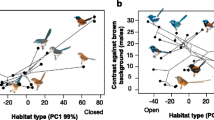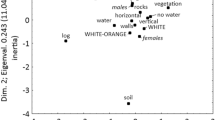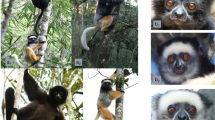Abstract
The pigmentation patterns of many carnivorous mammals comprise contrasting white patches of hair in different parts of the body whose evolution remains largely misunderstood. Some felids (Felidae) exhibit conspicuous white spots on the posterior part of the ears, while the ear color of others is uniform. On the basis that ear movement in felids has a role in intraspecific communication and that color contrast enhances detection, here it is hypothesized that white spots on ears may be particularly adaptive under conditions of poor visibility and thus be associated with the occupancy of closed habitats. This prediction was tested using phylogenetic logistic regression models with all species of extant felids. Results show a clear association between the occurrence of white spots on ears and preference for closed habitats, and this is independent of body size and whether species that occupy both closed and open habitats are considered as closed- or open-habitat specialists. Phylogenetic signal analyses indicate that the occurrence of white spots on ears is a highly conserved trait while habitat preferences are evolutionarily labile, suggesting that the presence of white spots may have partly contributed to the adaptation of felids to closed habitats. These findings indicate that some subtle pigment traits have fulfilled a significant role in determining the success of habitat occupancy by felids and possibly other mammals, which in turn has driven the evolutionary maintenance of such traits.



Similar content being viewed by others
References
Beauchamp G, Heeb P (2001) Social foraging and the evolution of white plumage. Evol Ecol Res 3:703–720
Blomberg SP, Garland T Jr, Ives AR (2003) Testing for phylogenetic signal in comparative data: behavioral traits are more labile. Evolution 57:717–745
Caro T (2011) The functions of black-and-white coloration in mammals. In: Stevens M, Merilaita S (eds) Animal Camouflage: Mechanisms and Function. Cambridge University Press, Cambridge, pp 298–329
Caro T, Walker H, Rossman Z, Hendrix M, Stankowich T (2017) Why is the giant panda black and white? Behav Ecol 28:657–667
Ey E, Fischer J (2009) The “acoustic adaptation hypothesis”—a review of the evidence from birds, anurans and mammals. Bioacoustics 19:21–48
Fritz SA, Purvis A (2010) Selectivity in mammalian extinction risk and threat types: a new measure of phylogenetic signal strength in binary traits. Conserv Biol 24:1042–1051
Galván I (2008) The importance of white on black: unmelanized plumage proportion predicts display complexity in birds. Behav Ecol Sociobiol 63:303–311
Galván I, Rodríguez-Martínez S, Carrascal LM (2018) Dark pigmentation limits thermal niche position in birds. Funct Ecol 32:1531–1540
Galván I, Sanz JJ (2009) Cheek plumage uniformity as a social status signal in great tits. Ann Zool Fenn 46:271–282
Hasson O (1997) Towards a general theory of biological signaling. J Theoret Biol 185:139–156
Ho LST, Ané C (2014) A linear-time algorithm for Gaussian and non-Gaussian trait evolution models. Syst Biol 63:397–408
Ives AR, Garland T Jr (2010) Phylogenetic logistic regression for binary dependent variables. Syst Biol 59:9–26
Johnson WE, Eizirik E, Pecon-Slattery J, Murphy WJ, Antunes A, Teeling E, O'Brien SJ (2006) The late Miocene radiation of modern Felidae: a genetic assessment. Science 311:73–77
Kiltie RA (2000) Scaling of visual acuity with body size in mammals and birds. Funct Ecol 14:226–234
Kingdon J (1977) East African Mammals. An Atlas of Evolution in Africa. Vol. IIIA. Carnivores. Academic Press, London
Kitchener AC, Van Valkenburgh B, Yamaguchi N (2010) Felid form and function. In: Macdonald D, Loveridge A (eds) The Biology and Conservation of Wild Felids. Oxford University Press, Oxford, pp 83–106
Mattern MY, McLennan DA (2000) Phylogeny and speciation of felids. Cladistics 16:232–253
Orme D, Freckleton R, Thomas G, Petzoldt T, Fritz S, Isaac N, Pearse W (2013) caper: Comparative Analyses of Phylogenetics and Evolution in R. Available at https://CRAN.R-project.org/package=caper. Accessed Sept 2018
Ortolani A (1999) Spots, stripes, tail tips and dark eyes: predicting the function of carnivore colour patterns using the comparative method. Biol J Linn Soc 67:433–476
Osorio D, Jones CD, Vorobyev M (1999) Accurate memory for colour but not pattern contrast in chicks. Curr Biol 9:199–202
Peters G, Tonkin-Leyhausen BA (1999) Evolution of acoustic communication signals of mammals: friendly close-range vocalizations in Felidae (Carnivora). J Mammal Evol 6:129–159
Schmidt V, Schaefer HM, Winkler H (2004) Conspicuousness, not colour as foraging cue in plant-animal signalling. Oikos 106:551–557
Stang AT, McRae SB (2009) Why some rails have white tails: the evolution of white undertail plumage and anti-predator signaling. Evol Ecol 23:943–961
Stanton LA, Sullivan MS, Fazio JM (2015) A standardized ethogram for the Felidae: a tool for behavioral researchers. Appl Anim Behav Sci 173:3–16
Werdelin L, Yamaguchi N, Johnson WE, O'Brien SJ (2010) Phylogeny and evolution of cats (Felidae). In: Macdonald D, Loveridge A (eds) The Biology and Conservation of Wild Felids. Oxford University Press, Oxford, pp 59–82
Wilson DE, Mittermeier RA (2009) Handbook of the Mammals of the World. Volume 1: Carnivores. Lynx Edicions, Barcelona
Acknowledgments
I thank Bernal Rodríguez Herrera and Paulina Rodríguez (Escuela de Biología, Universidad de Costa Rica) for help with access to bibliographic sources and data collection. I benefited by a Ramón y Cajal Fellowship (RYC-2012-10237) and the project CGL2015-67796-P from the Spain’s Ministry of Science, Innovation and Universities.
Author information
Authors and Affiliations
Corresponding author
Rights and permissions
About this article
Cite this article
Galván, I. Correlated Evolution of White Spots on Ears and Closed Habitat Preferences in Felids. J Mammal Evol 27, 519–523 (2020). https://doi.org/10.1007/s10914-019-09464-x
Published:
Issue Date:
DOI: https://doi.org/10.1007/s10914-019-09464-x




